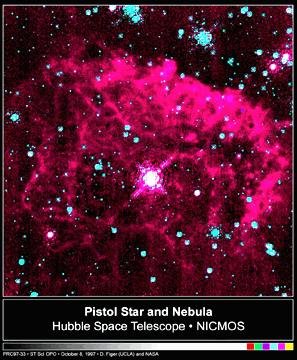What is the biggest star we know?
![]()

The Pistol Star appears as the bright white dot in the center of the image shown above. The Hubble Space Telescope's Near Infrared Camera and Multi-Object Spectrometer (NICMOS) was needed to take the picture, because the star is hidden at the galactic center, behind a great deal of obscuring dust. NICMOS' infrared vision can penetrate the dust to reveal the star. The star has enough raw power to blow off two expanding shells of gas (which are false-colored magenta) equal to the mass of several times our Sun. The largest shell is so big (4 light-years) it would stretch nearly all the way from our Sun to the next nearest star. The outbursts which created the shells seen by Hubble are estimated to be only 4,000 and 6,000 years old, respectively. Despite the mass loss by the star when it ejected this material, astronomers estimate the Pistol Star still has a mass of 100 times that of our Sun, and may have started out with as much as 200 solar masses of material! The star is 25,000 light-years away from Earth. Despite this great distance, the star would be visible to the naked eye if it were not for all the dust between it and the Earth.
UPDATE! As of January 2009, we now know about some other really big stars. One is called Eta Carinae. It has a size about 800 times that of our Sun, a mass about 100 times that of our Sun, and is about 4,000,000 times brighter than our Sun. And, yet, we do not think it is the biggest! Recent observations of a star called VY Canus Majoris show that it has a size between 600 and 2100 times the size of our Sun! However, this star is only about 500,000 times brighter than our Sun and 30 or so times more massive than our Sun. So how can it be so big? It is in a stage of its lifecycle called a red hypergiant, and while it is very big, it is rather cool in temperature compared to our Sun. VY Canis Majoris is located about 5000 light-years away from Earth.
![]()
The StarChild site is a service of the High Energy Astrophysics Science Archive Research Center (HEASARC), within the Astrophysics Science Division (ASD) at NASA/ GSFC.
StarChild Authors: The StarChild Team
StarChild Graphics & Music: Acknowledgments
StarChild Project Leader: Dr. Laura A.
Whitlock
Curator:
Responsible NASA Official: